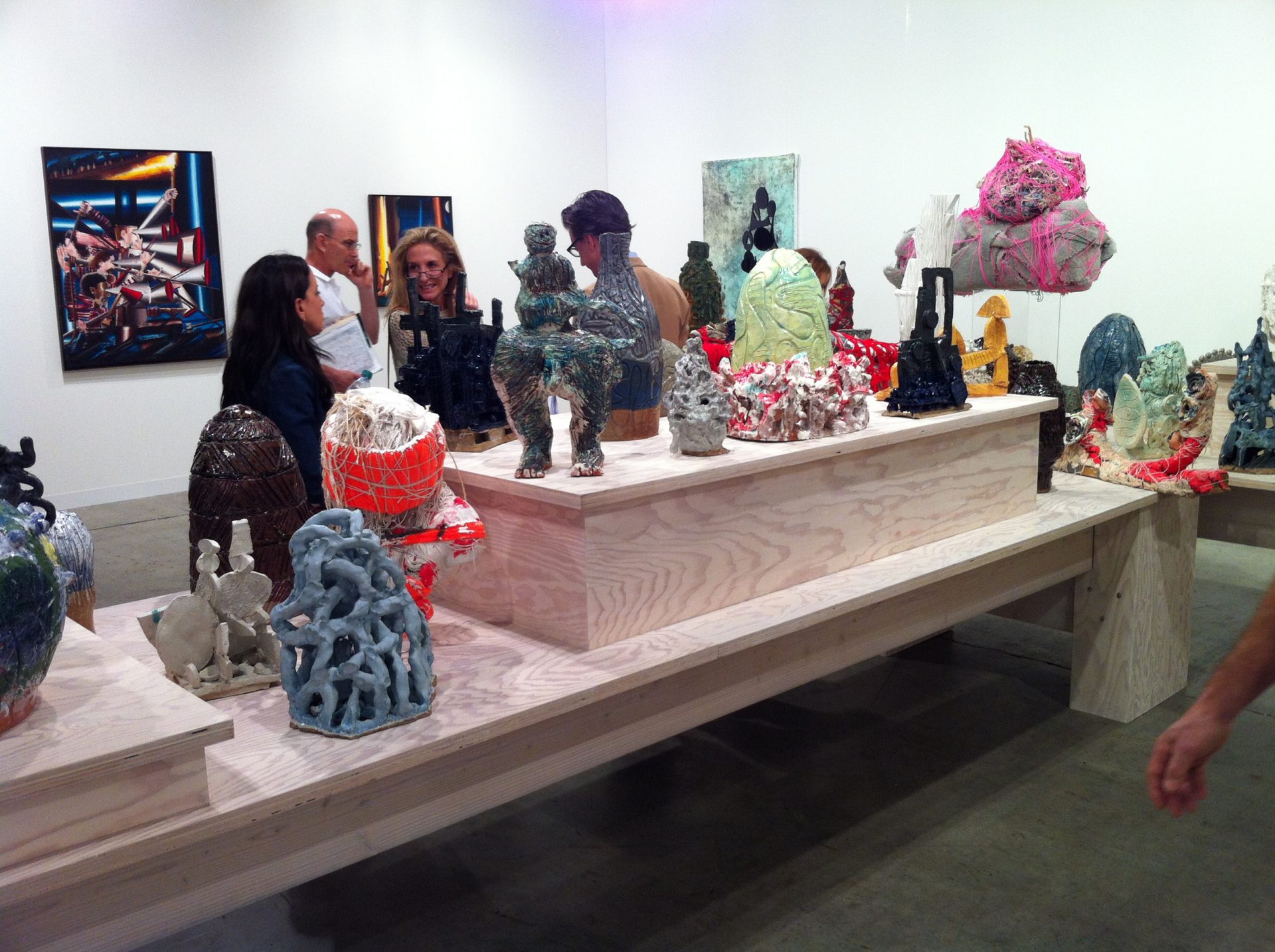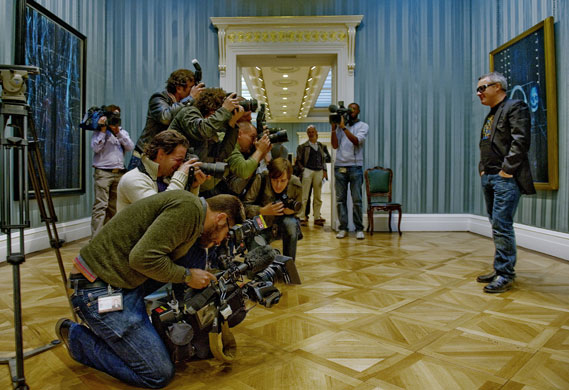Is this an “I told you so” moment in the career of Damien Hirst? There are many an artist that would claim he’s all hype and media driven, not a “real” artist. Media driven? Well, the image below certainly lends some credence that the media is there to watch his every step. Author Adrian Searle says this exhibition is a misstep.
One would think the light of the world’s economic reality would shine brighter on Damien Hirst today. His work is highly priced and this show could affect his prices. How much of a discount do you think one could ask for any of these paintings?
The truth, however, is that every artist takes or forsakes a risk with each new exhibition they mount. At what point does the artist change in her/his exploration of ideas and issues when they have had financial success with what they’re doing? Of course, success isn’t measured solely by ones ability to sell art, but in the case of Hirst, with his high prices, how can we not think also of that. If he wasn’t one of the world’s richest artists would the talk of money ever be so high on the agenda?
Maybe, these paintings will draw us in more over time and we’ll learn to like them more than at this moment. Time will tell the answer to that question.
Damien Hirst’s paintings are deadly dull | Adrian Searle:
“Art review: He may have done them on his own, but these doomy, gloomy paintings look positively amateurish
In pictures: Tour the show for yourself
Damien Hirst’s paintings hang in a single, long space at the Wallace Collection, on walls covered in blue silk with a vertical stripe. The setting is extremely theatrical – just like the rest of the museum. Through a doorway, at a distance, is Nicolas Poussin’s late 1630s Dance to the Music of Time. This stares back at Hirst’s painting of a single skull, on a murky blue-black background.
Hirst locates himself at the sharp end of art history. This is brave. It is also hubristic. Three-hundred and seventy years stand between Hirst’s No Love Lost and Poussin. In the rooms beyond hang Titian and Frans Hals, Rembrandt and any number of gilded rococo fripperies. But the artist Hirst is really confronting here is Francis Bacon, the absent ghost at the feast.
Bacon’s pin-striped businessmen from the 1950s appear to provide Hirst’s model. Instead of anxious executives, though, Hirst gives us the skull without the skin: skull after skull floating in blue gloom, along with glass ashtrays, cigarettes and lighters and glasses of water – half-full or half-empty, like life itself. It’s the old mortality shtick. There’s a shark’s jaw, open like a man-trap, an iguana that looks more dead than alive, and the odd stag beetle.
Everything is rendered in white against a full-strength blue-black that is as chemical and coppery as spilled ink. This colour infects everything it touches. The only flashes of colour are provided by the occasional lemon, a bit of intrusive dull green foliage, the plastic lighters. Rows of white dots decorate some paintings, in memory of Hirst’s interminable dot paintings, and most of the images are traversed by spidery white lines, like cracks in a pane of glass, or Bacon’s figure-trapping space frames. They outline the corners of tables or rooms, but most signify nothing more than the semblance of some sort of thoughtful, structural drawing. My suspicion is that they’re there just to give the surface a bit of life.
As well as Bacon, Jasper Johns’s skulls are somewhere in the mix; Alberto Giacometti’s worrying, nervous line; a touch of English neo-romanticism; and, perhaps most of all, the spectral phantoms of American painter Ross Bleckner, which similarly glow with a frosty chill against the eternal dark. Other Hirsts here depict dull, crusty roses in a vase, surrounded by flitting butterflies. The paint on the butterflies is all puckered up, as if Hirst has kissed them on to the surface. This is a nice touch.
The most successful works depict figures, half-hidden behind scuffed-on branches and tree trunks, which remind you of Bacon’s paintings of Van Gogh going to work. The titles are toe-curling and portentious, though: Witness at the Birth of Medusa is the hoariest. Others are called Guardian. I think of lurking editors hanging about in the woods, waiting to pounce.
There’s a lot of niggling overdrawing. In the 1950s Bacon was great at scribbling-in far-off figures or clunky cars on a distant highway. Hirst cannot compete. Bacon’s work had an air of authority; he also exercised a lot of quality control, and threw the things that didn’t work out. I don’t think Hirst does. This is painting as method acting. He just keeps at it. Hirst’s paintings lack the kind of theatricality and grandeur that made Bacon succeed. At its worst, Hirst’s drawing just looks amateurish and adolescent. His brushwork lacks that oomph and panache that makes you believe in the painter’s lies. He can’t yet carry it off.
I want to be encouraging. It’s tough, trying to out-paint your influences, tougher still to keep failing at it so publicly. As a painter, I too tried and failed. Whatever his borrowings, Hirst did all this himself, unaided by his armies of assistants. He fills up his art with dead things: even the iguanas look stuffed. But these paintings are a memento mori for a reputation.”
guardian.co.uk © Guardian News & Media Limited 2009 | Use of this content is subject to our Terms & Conditions | More Feeds

